

Compact Muon Solenoid
LHC, CERN
| CMS-EXO-21-009 ; CERN-EP-2022-268 | ||
| Search for new physics in the $ \tau $ lepton plus missing transverse momentum final state in proton-proton collisions at $ \sqrt{s} = $ 13 TeV | ||
| CMS Collaboration | ||
| 23 December 2022 | ||
| JHEP 09 (2023) 051 | ||
| Abstract: A search for physics beyond the standard model (SM) in the final state with a hadronically decaying tau lepton and a neutrino is presented. This analysis is based on data recorded by the CMS experiment from proton-proton collisions at a center-of-mass energy of 13 TeV at the LHC, corresponding to a total integrated luminosity of 138 fb$ ^{-1} $. The transverse mass spectrum is analyzed for the presence of new physics. No significant deviation from the SM prediction is observed. Limits are set on the production cross section of a W' boson decaying into a tau lepton and a neutrino. Lower limits are set on the mass of the sequential SM-like heavy charged vector boson and the mass of a quantum black hole. Upper limits are placed on the couplings of a new boson to the SM fermions. Constraints are put on a nonuniversal gauge interaction model and an effective field theory model. For the first time, upper limits on the cross section of $ t $-channel leptoquark (LQ) exchange are presented. These limits are translated into exclusion limits on the LQ mass and on its coupling in the $ t $-channel. The sensitivity of this analysis extends into the parameter space of LQ models that attempt to explain the anomalies observed in B meson decays. The limits presented for the various interpretations are the most stringent to date. Additionally, a model-independent limit is provided. | ||
| Links: e-print arXiv:2212.12604 [hep-ex] (PDF) ; CDS record ; inSPIRE record ; HepData record ; CADI line (restricted) ; | ||
| Figures | |

png pdf |
Figure 1:
Leading order Feynman diagram for the production and decay of a new heavy charged vector boson, W', decaying to $ \tau\overline{\nu}_{\!\tau} $. |

png pdf |
Figure 2:
Branching fractions $ \mathcal{B}(\mathrm{W^{'}}) $ as function of the mixing angle $ \cot\theta_{\text{E}} $ (solid lines), for W' boson decays in the NUGIM G(221) framework, as calculated in Refs. [65,66,67]. The total decay width $ \Gamma_{\text{tot}} $ (dotted lines) can also be determined as a function of the mixing angle. When re-scaled to accommodate the WH decay channel, the values associated with $ \cot\theta_{\text{E}} = $ 1 correspond to those in the SSM. |
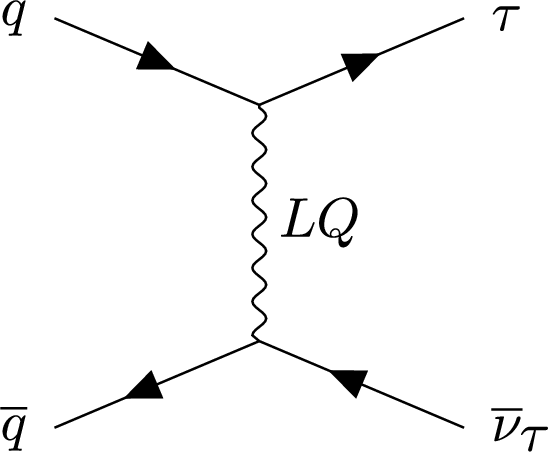
png pdf |
Figure 3:
Leading order Feynman diagram of the process $ \mathrm{p}\mathrm{p}\to\tau\overline{\nu}_{\!\tau} $ mediated via a leptoquark in the $ t $-channel. |
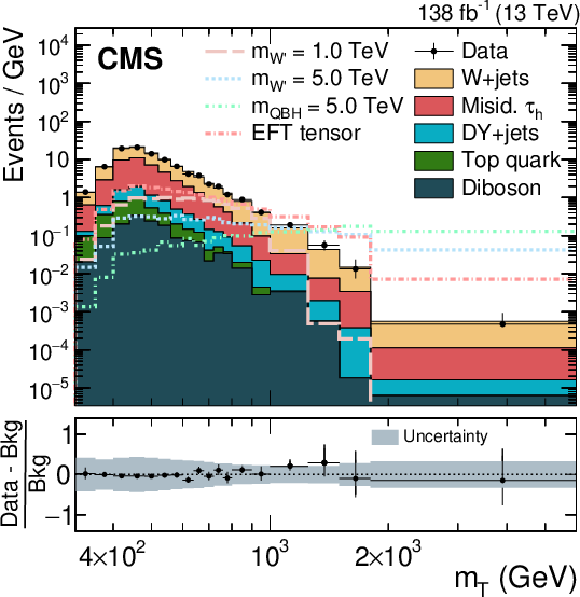
png pdf |
Figure 4:
The transverse mass distribution of the $ \tau_\mathrm{h}$+$p_{\mathrm{T}}^\text{miss} $ system observed in the 2016--2018 data (black dots with statistical uncertainty) as well as the expectation from SM processes (stacked histograms). The horizontal lines of the data points reflect the varying bin sizes. Different signal hypotheses normalized to 10 fb$ ^{-1} $ are illustrated as dashed lines for exemplary SSM W' boson, QBH, and EFT signal hypotheses. The ratios of the background-subtracted data yield to the expected background yield are presented in the lower panel. The combined statistical and systematic uncertainties in the background are represented by the grey shaded band in the ratio panel. |
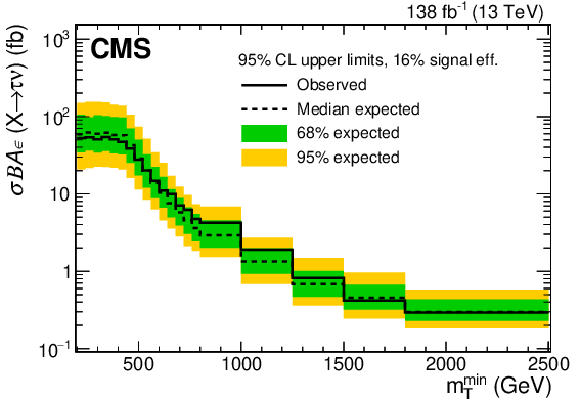
png pdf |
Figure 5:
Bayesian 95% CL model-independent upper limit on the product of signal cross section and branching fraction for the $ \tau $+$ \nu $ decay for a back-to-back $ \tau $ lepton plus $ p_{\mathrm{T}}^\text{miss} $ topology. To calculate this limit, all events for signal, background, and data are summed starting from a minimum $ m_{\mathrm{T}} $ threshold and then divided by the total number of events. No assumption on the signal shape is included in this limit, however a signal selection efficiency of 16% is assumed. The expected (dashed line) and observed (solid line) limits are shown as well as the 68% and 95% CL uncertainty bands (green and yellow, respectively). The uncertainty bands correspond to the sum in quadrature of PDF and scale variations. |
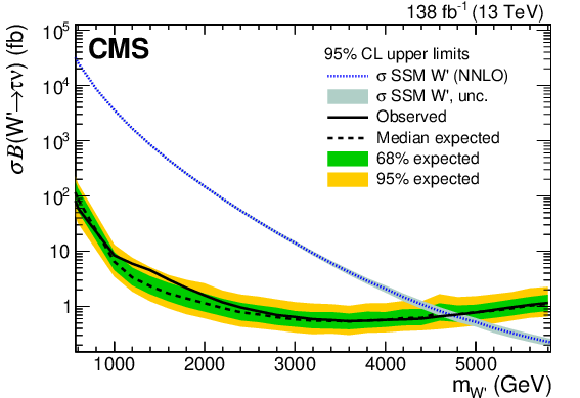
png pdf |
Figure 6:
Bayesian upper exclusion limits at 95% CL on the product of the cross section and branching fraction of a W' boson decaying to a $ \tau $ lepton and a neutrino in the SSM model. For this model, W' boson masses of up to 4.8 TeV can be excluded. The limit is given by the intersection of the observed (solid) limit and the theoretical cross section (blue dotted curve). The 68 and 95% quantiles of the limits are represented by the green and yellow bands, respectively. The $ \sigma \mathcal{B} $ for an SSM W' boson, along with its associated uncertainty, calculated at NNLO precision in QCD is shown. |

png pdf |
Figure 7:
Bayesian upper exclusion limits on the ratio $ g_{\mathrm{W^{'}}}/g_{\mathrm{W}} $ for an SSM-like W' boson are shown on the left. The unity coupling ratio (blue dotted curve) corresponds to the SSM common benchmark. The lower exclusion limits on the NUGIM G(221) mixing angle cot$ \theta_{\text{E}} $ are shown on the right as a function of the W' boson mass. The theoretically excluded region is shaded in grey. The 68 and 95% quantiles of the limits are represented by the green and yellow bands, respectively. |

png pdf |
Figure 7-a:
Bayesian upper exclusion limits on the ratio $ g_{\mathrm{W^{'}}}/g_{\mathrm{W}} $ for an SSM-like W' boson are shown. |

png pdf |
Figure 7-b:
The lower exclusion limits on the NUGIM G(221) mixing angle cot$ \theta_{\text{E}} $ are shown as a function of the W' boson mass. The theoretically excluded region is shaded in grey. The 68 and 95% quantiles of the limits are represented by the green and yellow bands, respectively. |
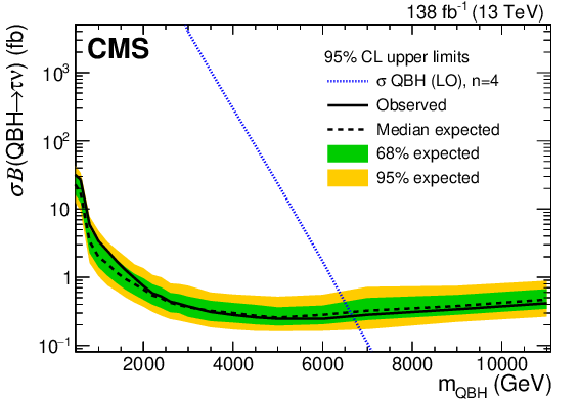
png pdf |
Figure 8:
Bayesian upper exclusion limits at 95% CL on the product of the production cross section and branching fraction of a QBH in an associated $ \tau $ lepton and neutrino final state. The 68 and 95% quantiles of the limits are represented by the green and yellow bands, respectively. Masses of up to 6.6 TeV are excluded at 95% CL. The limit is given by the intersection of the observed (solid) limit and the theoretical cross section (blue dotted curve). |

png pdf |
Figure 9:
Bayesian upper limits at 95% CL on the cross section of the process $ \mathrm{p}\mathrm{p}\to\tau\nu $ mediated by LQ exchange in the $ t $-channel. The inner (green) band and the outer (yellow) band indicate the regions containing 68 and 95%, respectively, of the distribution of limits expected under the background-only hypothesis. The predicted LQ cross section at LO in the three coupling benchmark scenarios is depicted in different colors for $ g_{\mathrm{U}}= $ 1. The uncertainty bands correspond to the sum in quadrature of PDF and scale variations. The first benchmark scenario considers only couplings to LH SM fermions (i.e., $ \beta_{\text{R}}^{ij} = $ 0) and is referred to as ``best fit LH''. The second benchmark, referred to as ``best fit LH+RH'', considers $ \left|\beta_{\text{R}}^{ \mathrm{b}\tau}\right| = $ 1 and all other $ \beta_{\text{R}}^{ij} = $ 0. In the third ``democratic'' benchmark, equal couplings only to LH fermions are assumed, i.e., $ \left|\beta_{\rm{L}}^{ij}\right| = $ 1 and $ \beta_{\rm{R}}^{ij} = $ 0 for all $ i $ and $ j $. |
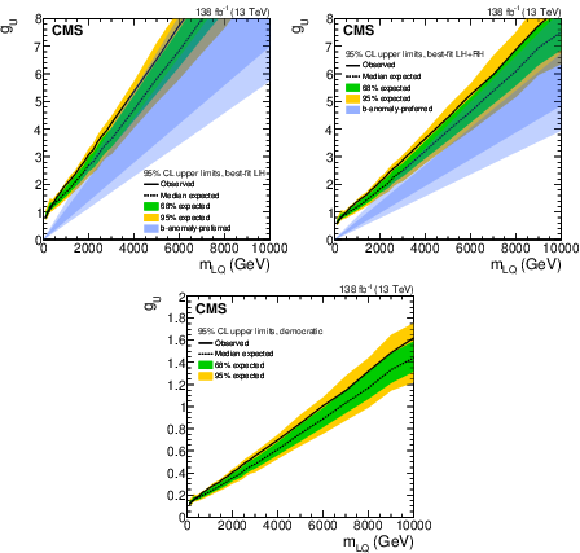
png pdf |
Figure 10:
Expected and observed upper limits of the LQ coupling $ g_{\mathrm{U}} $ as a function of the mass in the LH (left), LH+RH (right), and democratic (lower) scenarios. The blue band shows the 68 and 95% regions of $ g_{\mathrm{U}} $ preferred by the fit to the b anomalies data [44]. |
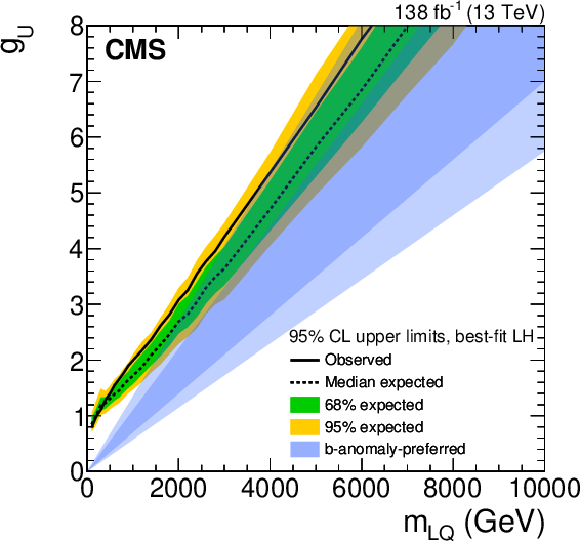
png pdf |
Figure 10-a:
Expected and observed upper limits of the LQ coupling $ g_{\mathrm{U}} $ as a function of the mass in the LH scenario. The blue band shows the 68 and 95% regions of $ g_{\mathrm{U}} $ preferred by the fit to the b anomalies data [44]. |

png pdf |
Figure 10-b:
Expected and observed upper limits of the LQ coupling $ g_{\mathrm{U}} $ as a function of the mass in the LH+RH scenario. The blue band shows the 68 and 95% regions of $ g_{\mathrm{U}} $ preferred by the fit to the b anomalies data [44]. |
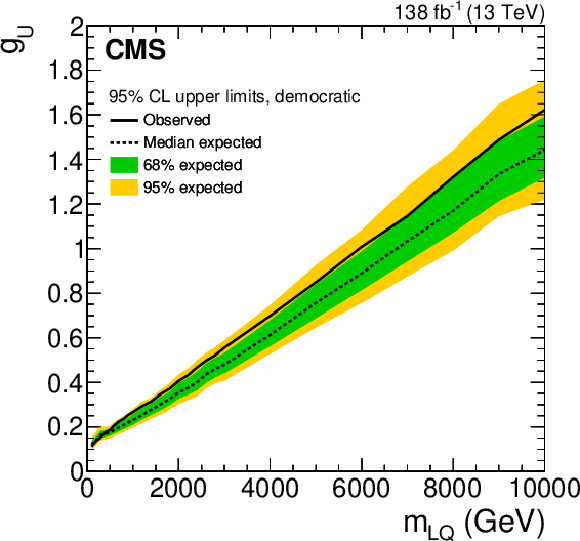
png pdf |
Figure 10-c:
Expected and observed upper limits of the LQ coupling $ g_{\mathrm{U}} $ as a function of the mass in the democratic scenario. The blue band shows the 68 and 95% regions of $ g_{\mathrm{U}} $ preferred by the fit to the b anomalies data [44]. |

png pdf |
Figure 11:
Bayesian upper exclusion limits at 95% CL on each of the Wilson coefficients described by the EFT model in Section 3 based on 2016--2018 data. The three different coupling types represent a LH vector coupling ($ \epsilon^{\text{cb}}_{\text{L}} $), scalar-tensor-like coupling ($ \epsilon^{\text{cb}}_{\text{S}_{\text{L}}} $, and tensor-like coupling ($ \epsilon^{\text{cb}}_{\text{T}} $)). The 68 and 95% quantiles of the limits are represented by the green and yellow bands, respectively. |
| Tables | |

png pdf |
Table 1:
Summary of 95% CL exclusion limits (expected and observed) derived from 2016--2018 data, for the physics models studied in this analysis: sequential standard model (SSM), nonuniversal gauge interaction model (NUGIM), a quantum black hole (QBH) interpretation, $ t $-channel leptoquark (LQ), and effective field interpretation (EFT). |
| Summary |
| A search for new resonant phenomena in the transverse mass distribution of a hadronically decaying $ \tau $ lepton and missing transverse momentum final state has been performed. The analysis uses 2016--2018 data collected with the CMS detector in proton-proton collisions with $ \sqrt{s}= $ 13 TeV at the LHC, corresponding to an integrated luminosity of 138 fb$ ^{-1} $. The newly developed DEEPTAU algorithm is used to identify $ \tau $ lepton candidates and to separate signal from background. Background from jets being misidentified as hadronically decaying $ \tau $ lepton candidates is derived from data. No significant deviation from the standard model expectations is observed. Upper limits are set at 95% confidence level on the product of the production cross section and branching fraction $ \sigma\mathcal{B} $ of a new resonance gauge boson (W') decaying to a $ \tau $ lepton and a neutrino. Lower limits are derived on the mass of a W' boson in the sequential standard model and on the mass of a quantum black hole. In the case of the generalized coupling model, upper limits on $ \sigma\mathcal{B} $ are translated into upper exclusion limits on the ratio of the couplings of the W' boson to that of the standard model W boson, $ g_{\mathrm{W^{'}}}/g_{\mathrm{W}} $. Similarly, limits are obtained on the mixing angle $ \theta_{E} $ for the nonuniversal gauge interaction model and on the Wilson coefficients for an effective field theory model. The process of $ t $-channel leptoquark (LQ) exchange is targeted explicitly in this analysis. For the first time, upper limits are placed on the cross section of the $ \mathrm{p}\mathrm{p}\to\tau\nu $ process mediated by $ t $-channel LQ exchange. Three benchmark coupling scenarios are tested that correspond to the best fits to the flavor anomaly data and to a generic democratic flavor structure. Significant portions of the LQ parameter space are excluded by placing upper limits on the LQ coupling $ g_{\text{U}} $ as a function of the LQ mass, including parts of the region preferred by a vector LQ explanation of the anomalies. Additionally, a model-independent limit is provided. The limits obtained for the various interpretations presented are the most stringent to date. |
| References | ||||
| 1 | ATLAS Collaboration | Search for a heavy charged boson in events with a charged lepton and missing transverse momentum from pp collisions at $ \sqrt{s}= $ 13 TeV with the ATLAS detector | PRD 100 (2019) 052013 | 1906.05609 |
| 2 | CMS Collaboration | Search for new physics in the lepton plus missing transverse momentum final state in proton-proton collisions at $ \sqrt{s}= $ 13 TeV | JHEP 07 (2022) 067 | CMS-EXO-19-017 2202.06075 |
| 3 | G. Altarelli, B. Mele, and M. Ruiz-Altaba | Searching for new heavy vector bosons in $ \mathrm{p}\overline{\mathrm{p}} $ colliders | Z. Phys. C 45 (1989) 109 | |
| 4 | CMS Collaboration | Search for W' decaying to tau lepton and neutrino in proton-proton collisions at $ \sqrt{s}= $ 8 TeV | PLB 755 (2016) 196 | CMS-EXO-12-011 1508.04308 |
| 5 | CMS Collaboration | Search for a W' boson decaying to a $ \tau $ lepton and a neutrino in proton-proton collisions at $ \sqrt{s} = $ 13 TeV | PLB 792 (2019) 107 | CMS-EXO-17-008 1807.11421 |
| 6 | ATLAS Collaboration | Search for high-mass resonances decaying to $ \tau\nu $ in pp collisions at $ \sqrt{s}= $ 13 TeV with the ATLAS detector | PRL 120 (2018) 161802 | 1801.06992 |
| 7 | BaBar Collaboration | Evidence for an excess of $ \bar{B} \to D^{(*)} \tau^-\bar{\nu}_\tau $ decays | PRL 109 (2012) 101802 | 1205.5442 |
| 8 | BaBar Collaboration | Measurement of an excess of $ \bar{B} \to D^{(*)}\tau^- \bar{\nu}_\tau $ decays and implications for charged higgs bosons | PRD 88 (2013) 072012 | 1303.0571 |
| 9 | Belle Collaboration | Measurement of the branching ratio of $ \bar{B} \to D^{(\ast)} \tau^- \bar{\nu}_\tau $ relative to $ \bar{B} \to D^{(\ast)} \ell^- \bar{\nu}_\ell $ decays with hadronic tagging at Belle | PRD 92 (2015) 072014 | 1507.03233 |
| 10 | Belle Collaboration | Measurement of the $ \tau $ lepton polarization and $ R(D^*) $ in the decay $ \bar{B} \to D^* \tau^- \bar{\nu}_\tau $ | PRL 118 (2017) 211801 | 1612.00529 |
| 11 | Belle Collaboration | Measurement of the $ \tau $ lepton polarization and $ R(D^*) $ in the decay $ \bar{B} \rightarrow D^* \tau^- \bar{\nu}_\tau $ with one-prong hadronic $ \tau $ decays at Belle | PRD 97 (2018) 012004 | 1709.00129 |
| 12 | Belle Collaboration | Measurement of $ \mathcal{R}(D) $ and $ \mathcal{R}(D^*) $ with a semileptonic tagging method | PRL 124 (2020) 161803 | 1910.05864 |
| 13 | LHCb Collaboration | Measurement of the ratio of branching fractions $ \mathcal{B}(\bar{B}^0 \to D^{*+}\tau^{-}\bar{\nu}_{\tau})/\mathcal{B}(\bar{B}^0 \to D^{*+}\mu^{-}\bar{\nu}_{\mu}) $ | [Erratum: PRL 115 (2015) 159901] PRL 115 (2015) 111803 |
1506.08614 |
| 14 | LHCb Collaboration | Measurement of the ratio of the $ B^0 \to D^{*-} \tau^+ \nu_{\tau} $ and $ B^0 \to D^{*-} \mu^+ \nu_{\mu} $ branching fractions using three-prong $ \tau $-lepton decays | PRL 120 (2018) 171802 | 1708.08856 |
| 15 | LHCb Collaboration | Test of lepton flavor universality by the measurement of the $ B^0 \to D^{*-} \tau^+ \nu_{\tau} $ branching fraction using three-prong $ \tau $ decays | PRD 97 (2018) 072013 | 1711.02505 |
| 16 | LHCb Collaboration | Measurement of the ratios of branching fractions $ \mathcal{R}(D^{*}) $ and $ \mathcal{R}(D^{0}) $ | 2302.02886 | |
| 17 | LHCb Collaboration | Search for lepton-universality violation in $ B^+\to K^+\ell^+\ell^- $ decays | PRL 122 (2019) 191801 | 1903.09252 |
| 18 | LHCb Collaboration | Test of lepton universality with $ B^{0} \rightarrow K^{*0}\ell^{+}\ell^{-} $ decays | JHEP 08 (2017) 055 | 1705.05802 |
| 19 | LHCb Collaboration | Test of lepton universality in beauty-quark decays | Nature Phys. 18 (2022) 277 | 2103.11769 |
| 20 | LHCb Collaboration | Tests of lepton universality using $ B^0\to K^0_S \ell^+ \ell^- $ and $ B^+\to K^{*+} \ell^+ \ell^- $ decays | PRL 128 (2022) 191802 | 2110.09501 |
| 21 | LHCb Collaboration | Measurement of lepton universality parameters in $ B^+\to K^+\ell^+\ell^- $ and $ B^0\to K^{*0}\ell^+\ell^- $ decays | 2212.09153 | |
| 22 | M. Tanaka and R. Watanabe | New physics in the weak interaction of $ \bar B \to D^{(*)}\tau\bar\nu $ | PRD 87 (2013) 034028 | 1212.1878 |
| 23 | Y. Sakaki, M. Tanaka, A. Tayduganov, and R. Watanabe | Testing leptoquark models in $ \bar B \to D^{(*)} \tau \bar\nu $ | PRD 88 (2013) 094012 | 1309.0301 |
| 24 | I. Doršner, S. Fajfer, N. Košnik, and I. Nišandžić | Minimally flavored colored scalar in $ \bar B \to D^{(*)} \tau \bar \nu $ and the mass matrices constraints | JHEP 11 (2013) 084 | 1306.6493 |
| 25 | B. Dumont, K. Nishiwaki, and R. Watanabe | LHC constraints and prospects for $ S_1 $ scalar leptoquark explaining the $ \bar B \to D^{(*)} \tau \bar\nu $ anomaly | PRD 94 (2016) 034001 | 1603.05248 |
| 26 | I. Doršner, S. Fajfer, D. A. Faroughy, and N. Košnik | The role of the $ S_3 $ GUT leptoquark in flavor universality and collider searches | JHEP 10 (2017) 188 | 1706.07779 |
| 27 | D. Bečirević et al. | Scalar leptoquarks from grand unified theories to accommodate the $ b $-physics anomalies | PRD 98 (2018) 055003 | 1806.05689 |
| 28 | A. Crivellin, D. Müller, and T. Ota | Simultaneous explanation of $ R(D^{(*)}) $ and $ \mathrm{b}\to\mathrm{s}\mu^{+}\mu^{-} $: the last scalar leptoquarks standing | JHEP 09 (2017) 040 | 1703.09226 |
| 29 | B. Gripaios, M. Nardecchia, and S. A. Renner | Composite leptoquarks and anomalies in $ b $-meson decays | JHEP 05 (2015) 006 | 1412.1791 |
| 30 | M. Bauer and M. Neubert | Minimal leptoquark explanation for the $ R_{D^{(*)}} $, $ R_K $, and $ (g-2)_\mu $ anomalies | PRL 116 (2016) 141802 | 1511.01900 |
| 31 | E. Coluccio Leskow, G. D'Ambrosio, A. Crivellin, and D. Müller | $ (g-2)_\mu $, lepton flavor violation, and Z decays with leptoquarks: Correlations and future prospects | PRD 95 (2017) 055018 | 1612.06858 |
| 32 | D. Bečirević and O. Sumensari | A leptoquark model to accommodate $ R_K^\mathrm{exp} < R_K^\mathrm{SM} $ and $ R_{K^\ast}^\mathrm{exp} < R_{K^\ast}^\mathrm{SM} $ | JHEP 08 (2017) 104 | 1704.05835 |
| 33 | G. Hiller and I. Nišandžić | $ R_K $ and $ R_{K^{\ast}} $ beyond the standard model | PRD 96 (2017) 035003 | 1704.05444 |
| 34 | G. Hiller, D. Loose, and I. Nišandžić | Flavorful leptoquarks at hadron colliders | PRD 97 (2018) 075004 | 1801.09399 |
| 35 | L. Di Luzio, A. Greljo, and M. Nardecchia | Gauge leptoquark as the origin of B-physics anomalies | PRD 96 (2017) 115011 | 1708.08450 |
| 36 | L. Di Luzio et al. | Maximal flavour violation: a cabibbo mechanism for leptoquarks | JHEP 11 (2018) 081 | 1808.00942 |
| 37 | L. Calibbi, A. Crivellin, and T. Li | Model of vector leptoquarks in view of the $ b $-physics anomalies | PRD 98 (2018) 115002 | 1709.00692 |
| 38 | M. Bordone, C. Cornella, J. Fuentes-Martin, and G. Isidori | A three-site gauge model for flavor hierarchies and flavor anomalies | PLB 779 (2018) 317 | 1712.01368 |
| 39 | R. Barbieri and A. Tesi | $ b $-decay anomalies in Pati-Salam SU(4) | EPJC 78 (2018) 193 | 1712.06844 |
| 40 | D. Buttazzo, A. Greljo, G. Isidori, and D. Marzocca | B-physics anomalies: a guide to combined explanations | JHEP 11 (2017) 044 | 1706.07808 |
| 41 | D. Marzocca | Addressing the b-physics anomalies in a fundamental composite higgs model | JHEP 07 (2018) 121 | 1803.10972 |
| 42 | M. J. Baker, J. Fuentes-Martin, G. Isidori, and M. König | High-$ p_\mathrm{T} $ signatures in vector-leptoquark models | EPJC 79 (2019) 334 | 1901.10480 |
| 43 | C. Cornella, J. Fuentes-Martin, and G. Isidori | Revisiting the vector leptoquark explanation of the b-physics anomalies | JHEP 07 (2019) 168 | 1903.11517 |
| 44 | C. Cornella et al. | Reading the footprints of the b-meson flavor anomalies | JHEP 08 (2021) 050 | 2103.16558 |
| 45 | CMS Collaboration | Constraints on models of scalar and vector leptoquarks decaying to a quark and a neutrino at $ \sqrt{s} = $ 13 TeV | PRD 98 (2018) 032005 | CMS-SUS-18-001 1805.10228 |
| 46 | ATLAS Collaboration | Search for a scalar partner of the top quark in the all-hadronic $ t{\bar{t}} $ plus missing transverse momentum final state at $ \sqrt{s} = $ 13 TeV with the ATLAS detector | EPJC 80 (2020) 737 | 2004.14060 |
| 47 | ATLAS Collaboration | Search for new phenomena in final states with $ b $-jets and missing transverse momentum in $ \sqrt{s} = $ 13 TeV pp collisions with the ATLAS detector | JHEP 05 (2021) 093 | 2101.12527 |
| 48 | CMS Collaboration | Search for singly and pair-produced leptoquarks coupling to third-generation fermions in proton-proton collisions at $ \sqrt{s} $ = 13 TeV | PLB 819 (2021) 136446 | CMS-EXO-19-015 2012.04178 |
| 49 | ATLAS Collaboration | Search for pair production of scalar leptoquarks decaying into first- or second-generation leptons and top quarks in proton-proton collisions at $ \sqrt{s}= $ 13 TeV with the ATLAS detector | EPJC 81 (2021) 313 | 2010.02098 |
| 50 | CMS Collaboration | Search for leptoquarks coupled to third-generation quarks in proton-proton collisions at $ \sqrt{s}= $ 13 TeV | PRL 121 (2018) 241802 | 1809.05558 |
| 51 | ATLAS Collaboration | Search for pair production of third-generation scalar leptoquarks decaying into a top quark and a $ \tau $-lepton in pp collisions at $ \sqrt{s} $ = 13 TeV with the ATLAS detector | JHEP 06 (2021) 179 | 2101.11582 |
| 52 | CMS Collaboration | Search for third-generation scalar leptoquarks decaying to a top quark and a $ \tau $ lepton at $ \sqrt{s}= $ 13 TeV | EPJC 78 (2018) 707 | 1803.02864 |
| 53 | ATLAS Collaboration | Search for new phenomena in pp collisions in final states with tau leptons, b-jets, and missing transverse momentum with the ATLAS detector | PRD 104 (2021) 112005 | 2108.07665 |
| 54 | CMS Collaboration | Search for heavy neutrinos and third-generation leptoquarks in hadronic states of two $ \tau $ leptons and two jets in proton-proton collisions at $ \sqrt{s}= $ 13 TeV | JHEP 03 (2019) 170 | CMS-EXO-17-016 1811.00806 |
| 55 | CMS Collaboration | Search for a singly produced third-generation scalar leptoquark decaying to a $ \tau $ lepton and a bottom quark in proton-proton collisions at $ \sqrt{s}= $ 13 TeV | JHEP 07 (2018) 115 | CMS-EXO-17-029 1806.03472 |
| 56 | L. Di Luzio and M. Nardecchia | What is the scale of new physics behind the $ B $-flavour anomalies? | EPJC 77 (2017) 536 | 1706.01868 |
| 57 | A. Greljo, J. Martin Camalich, and J. D. Ruiz-Álvarez | Mono-$ \tau $ signatures at the LHC constrain explanations of $ b $-decay anomalies | PRL 122 (2019) 131803 | 1811.07920 |
| 58 | R. N. Mohapatra and J. C. Pati | Natural left-right symmetry | PRD 11 (1975) 2558 | |
| 59 | R. N. Mohapatra and J. C. Pati | Left-right gauge symmetry and an isoconjugate model of CP violation | PRD 11 (1975) 566 | |
| 60 | S. Dimopoulos and G. L. Landsberg | Black holes at the LHC | PRL 87 (2001) 161602 | hep-ph/0106295 |
| 61 | S. B. Giddings and S. D. Thomas | High-energy colliders as black hole factories: The end of short distance physics | PRD 65 (2002) 056010 | hep-ph/0106219 |
| 62 | P. Meade and L. Randall | Black holes and quantum gravity at the LHC | JHEP 05 (2008) 003 | 0708.3017 |
| 63 | CMS Collaboration | HEPData record for this analysis | link | |
| 64 | CMS Collaboration | Performance of the CMS level-1 trigger in proton-proton collisions at $ \sqrt{s}= $ 13 TeV | JINST 15 (2020) P10017 | CMS-TRG-17-001 2006.10165 |
| 65 | CMS Collaboration | HEPData record for this analysis | link | |
| 66 | CMS Collaboration | The CMS trigger system | JINST 12 (2017) P01020 | CMS-TRG-12-001 1609.02366 |
| 67 | CMS Collaboration | The CMS experiment at the CERN LHC | JINST 3 (2008) S08004 | |
| 68 | C.-W. Chiang, N. G. Deshpande, X.-G. He, and J. Jiang | The family $ SU(2)_l \times SU(2)_h \times U(1) $ model | PRD 81 (2010) 015006 | 0911.1480 |
| 69 | Y. G. Kim and K. Y. Lee | Early LHC bound on the W' boson mass in the nonuniversal gauge interaction model | PLB 706 (2012) 367 | 1105.2653 |
| 70 | L. Edelhauser and A. Knochel | Observing nonstandard W' and Z' through the third generation and Higgs lens | 1408.0914 | |
| 71 | N. Arkani-Hamed, S. Dimopoulos, and G. Dvali | The hierarchy problem and new dimensions at a millimeter | PLB 429 (1998) 263 | |
| 72 | W. Buchmüller, R. Rückl, and D. Wyler | Leptoquarks in lepton - quark collisions | [Erratum: \it Phys. Lett. B 448 () 320], 1987 PLB 191 (1987) 442 |
|
| 73 | S. Agostinelli et al. | GEANT 4---a simulation toolkit | NIM A 506 (2003) 250 | |
| 74 | CMS Collaboration | Precision luminosity measurement in proton-proton collisions at $ \sqrt{s}= $ 13 TeV in 2015 and 2016 at CMS | EPJC 81 (2021) 800 | CMS-LUM-17-003 2104.01927 |
| 75 | CMS Collaboration | CMS luminosity measurement for the 2017 data-taking period at $ \sqrt{s}= $ 13 TeV | CMS Physics Analysis Summary, 2018 link |
CMS-PAS-LUM-17-004 |
| 76 | CMS Collaboration | CMS luminosity measurement for the 2018 data-taking period at $ \sqrt{s}= $ 13 TeV | CMS Physics Analysis Summary, 2019 link |
CMS-PAS-LUM-18-002 |
| 77 | P. Skands, S. Carrazza, and J. Rojo | Tuning PYTHIA 8.1: the monash 2013 tune | EPJC 74 (2014) 3024 | 1404.5630 |
| 78 | CMS Collaboration | Extraction and validation of a new set of CMS PYTHIA8 tunes from underlying-event measurements | EPJC 80 (2020) 4 | CMS-GEN-17-001 1903.12179 |
| 79 | T. Sjöstrand et al. | An introduction to PYTHIA 8.2 | Comp. Phys. Comm. 191 (2015) 159 | 1410.3012 |
| 80 | R. D. Ball et al. | Parton distributions with LHC data | NPB 867 (2013) 244 | 1207.1303 |
| 81 | NNPDF Collaboration | Parton distributions from high-precision collider data | EPJC 77 (2017) 663 | 1706.00428 |
| 82 | J. Alwall et al. | Madgraph 5: going beyond | JHEP 06 (2011) 128 | 1106.0522 |
| 83 | J. Alwall et al. | The automated computation of tree-level and next-to-leading order differential cross sections, and their matching to parton shower simulations | JHEP 07 (2014) 079 | 1405.0301 |
| 84 | CMS Collaboration | Search for a third-generation leptoquark coupled to a $ \tau $ lepton and a b quark through single, pair, and nonresonant production in proton-proton collisions at $ \sqrt{s} $ = 13 TeV | Submitted to JHEP, 2023 | CMS-EXO-19-016 2308.07826 |
| 85 | D. M. Gingrich | Quantum black holes with charge, colour, and spin at the LHC | JPG 37 (2010) 105008 | 0912.0826 |
| 86 | J. Pumplin et al. | New generation of parton distributions with uncertainties from global QCD analysis | JHEP 07 (2002) 012 | hep-ph/0201195 |
| 87 | R. Alonso, A. Kobach, and J. Martin Camalich | New physics in the kinematic distributions of $ \bar B\to D^{(*)}\tau^-(\to\ell^-\bar\nu_\ell\nu_\tau)\bar\nu_\tau $ | PRD 94 (2016) 094021 | 1602.07671 |
| 88 | P. Nason | A new method for combining NLO QCD with shower monte carlo algorithms | JHEP 11 (2004) 040 | hep-ph/0409146 |
| 89 | S. Frixione, P. Nason, and C. Oleari | Matching NLO QCD computations with parton shower simulations: the POWHEG method | JHEP 11 (2007) 070 | 0709.2092 |
| 90 | S. Alioli, P. Nason, C. Oleari, and E. Re | A general framework for implementing NLO calculations in shower monte carlo programs: the POWHEG BOX | JHEP 06 (2010) 043 | 1002.2581 |
| 91 | A. Buckley et al. | LHAPDF6: parton density access in the LHC precision era | EPJC 75 (2015) 132 | 1412.7420 |
| 92 | G. Balossini et al. | Combination of electroweak and QCD corrections to single W production at the Fermilab Tevatron and the CERN LHC | JHEP 01 (2010) 013 | 0907.0276 |
| 93 | J. R. Andersen et al. | Les Houches 2013: Physics at TeV colliders: Standard model working group report | 1405.1067 | |
| 94 | A. Arbuzov et al. | Update of the MCSANC monte carlo integrator, v. 1.20 | JETP Lett. 103 (2016) 131 | 1509.03052 |
| 95 | S. G. Bondarenko and A. A. Sapronov | NLO EW and QCD proton-proton cross section calculations with mcsanc-v1.01 | Comput. Phys. Commun. 184 (2013) 2343 | 1301.3687 |
| 96 | CMS Collaboration | Particle-flow reconstruction and global event description with the CMS detector | JINST 12 (2017) P10003 | CMS-PRF-14-001 1706.04965 |
| 97 | M. Cacciari, G. P. Salam, and G. Soyez | The anti-$ k_{\mathrm{T}} $ jet clustering algorithm | JHEP 04 (2008) 063 | 0802.1189 |
| 98 | M. Cacciari, G. P. Salam, and G. Soyez | Fastjet user manual | EPJC 72 (2012) 1896 | 1111.6097 |
| 99 | CMS Collaboration | Jet energy scale and resolution in the CMS experiment in pp collisions at 8 tev | JINST 12 (2017) P02014 | CMS-JME-13-004 1607.03663 |
| 100 | CMS Collaboration | Performance of missing transverse momentum reconstruction in proton-proton collisions at $ \sqrt{s}= $ 13 TeV using the CMS detector | JINST 14 (2019) P07004 | CMS-JME-17-001 1903.06078 |
| 101 | CMS Collaboration | Reconstruction and identification of $ \tau $ lepton decays to hadrons and $ \nu_{\tau} $ at CMS | JINST 11 (2016) P01019 | CMS-TAU-14-001 1510.07488 |
| 102 | CMS Collaboration | Identification of hadronic tau lepton decays using a deep neural network | JINST 17 (2022) P07023 | CMS-TAU-20-001 2201.08458 |
| 103 | CMS Collaboration | Electron and photon reconstruction and identification with the CMS experiment at the CERN LHC | JINST 16 (2021) P05014 | CMS-EGM-17-001 2012.06888 |
| 104 | CMS Collaboration | Performance of the CMS muon detector and muon reconstruction with proton-proton collisions at $ \sqrt{s}= $ 13 TeV | JINST 13 (2018) P06015 | CMS-MUO-16-001 1804.04528 |
| 105 | J. Butterworth et al. | PDF4LHC recommendations for LHC Run II | JPG 43 (2016) 023001 | 1510.03865 |
| 106 | CMS Collaboration | Measurement of the inelastic proton-proton cross section at $ \sqrt{s}= $ 13 TeV | JHEP 07 (2018) 161 | CMS-FSQ-15-005 1802.02613 |
| 107 | R. Barlow and C. Beeston | Fitting using finite monte carlo samples | Computer Physics Communications 77 (1993) 219 | |
| 108 | Particle Data Group , R. L. Workman et al. | Review of particle physics | PTEP 2022 (2022) 083C01 | |
| 109 | The ATLAS Collaboration, The CMS Collaboration, and the LHC Higgs Combination Group | Procedure for the LHC Higgs boson search combination in Summer 2011 | Technical Report CMS-NOTE-2011-005, ATL-PHYS-PUB-2011-11, 2011 | |
| 110 | L. Moneta et al. | The RooStats project | in 13th International Workshop on Advanced Computing and Analysis Techniques in Physics Research (ACAT). PoS(ACAT)057, 2010. link |
1009.1003 |

|
Compact Muon Solenoid LHC, CERN |

|

|

|

|

|

|